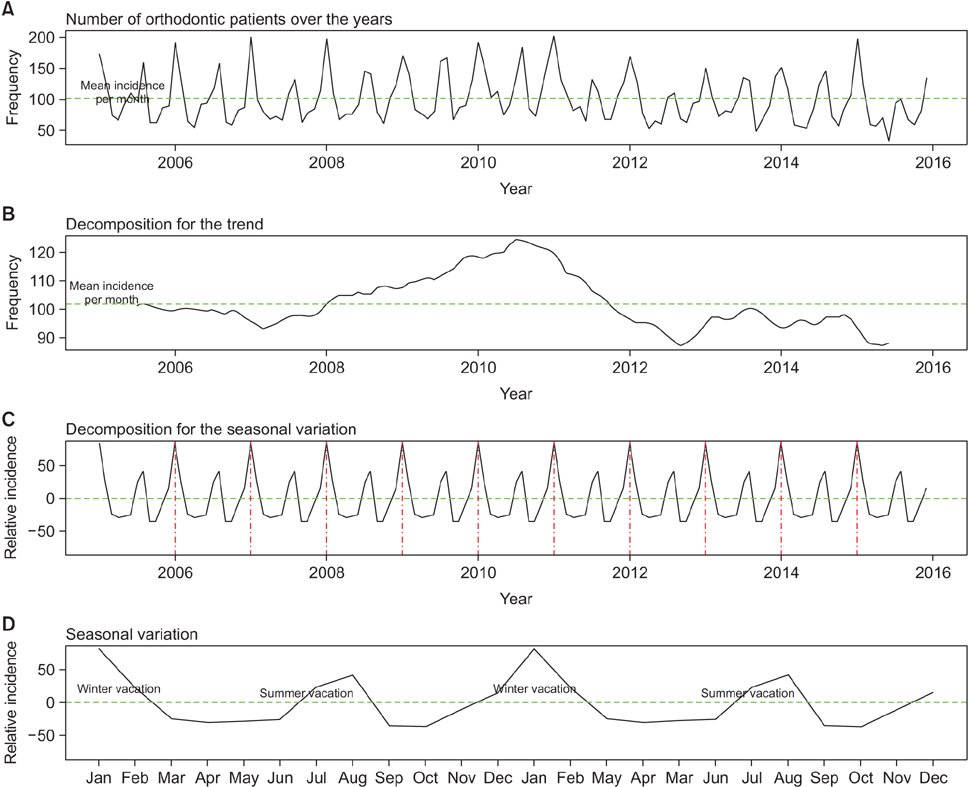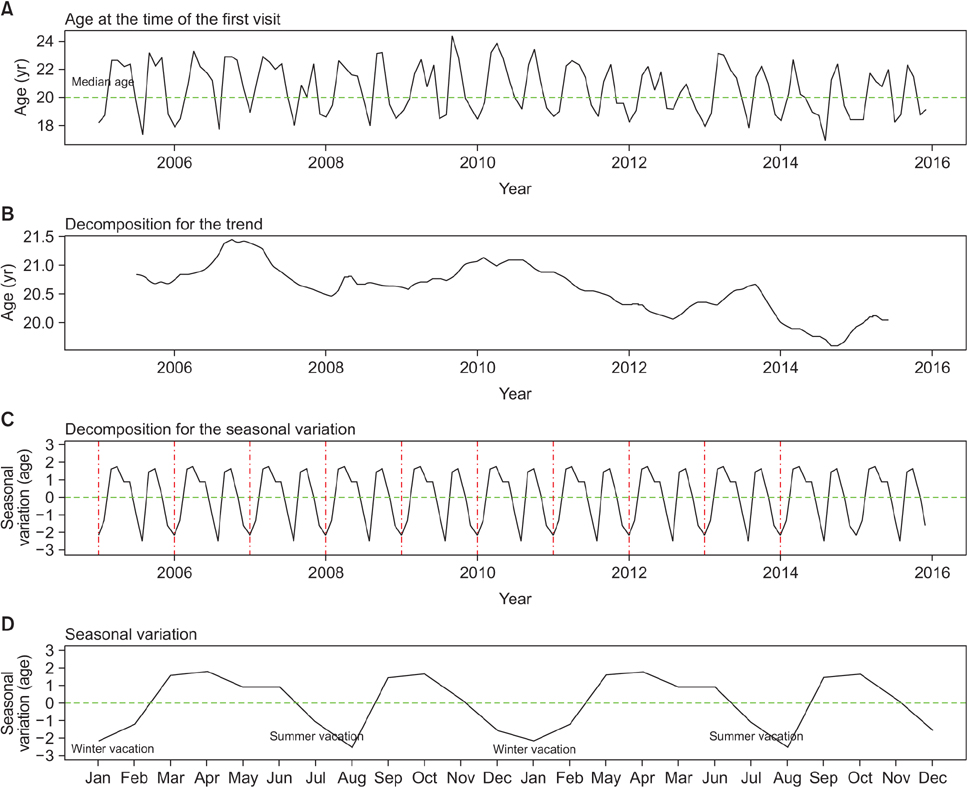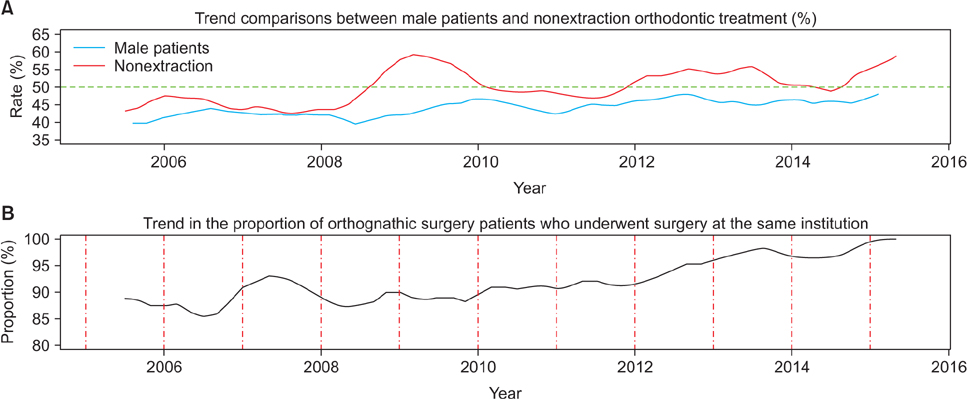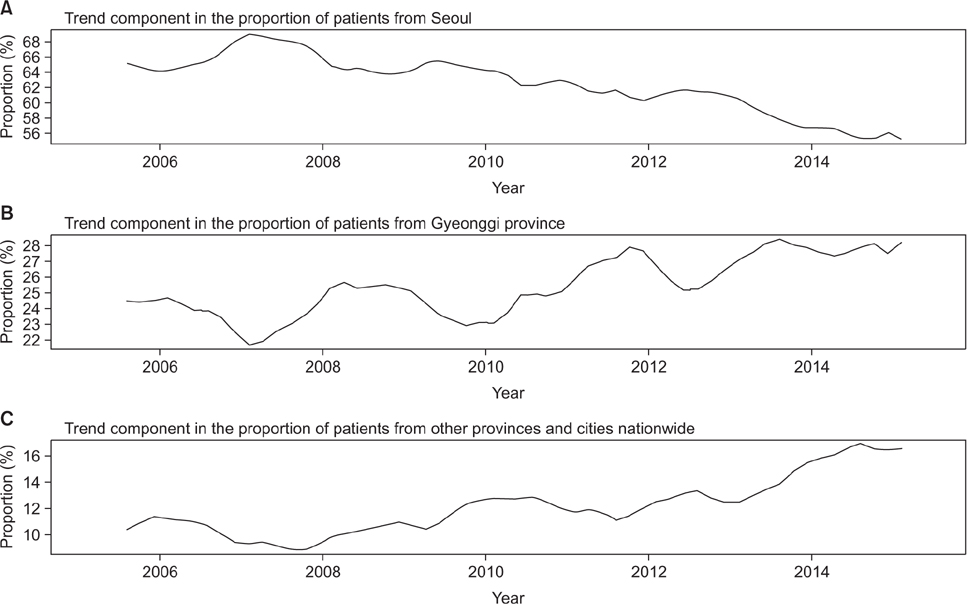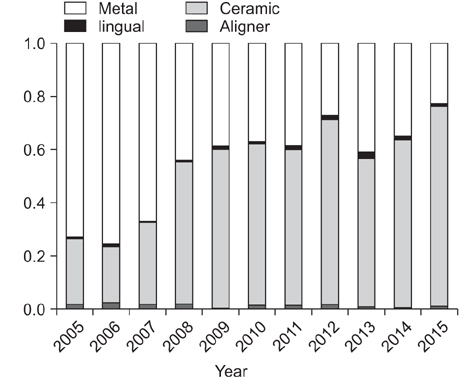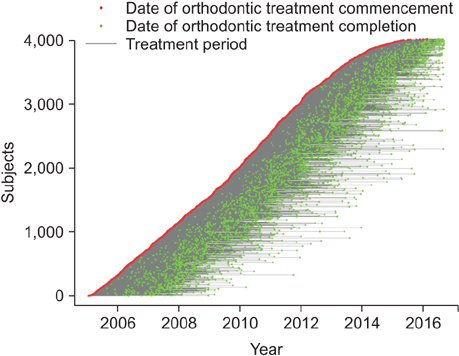Korean J Orthod.
2017 Sep;47(5):298-305. 10.4041/kjod.2017.47.5.298.
Time series analysis of patients seeking orthodontic treatment at Seoul National University Dental Hospital over the past decade
- Affiliations
-
- 1Department of Dentistry, Seoul National University School of Dentistry, Seoul, Korea.
- 2Department of Orthodontics, Graduate School, Seoul National University, Seoul, Korea.
- 3Department of Orthodontics, Seoul National University School of Dentistry and Dental Research Institute, Seoul, Korea. nonext@snu.ac.kr
- KMID: 2389145
- DOI: http://doi.org/10.4041/kjod.2017.47.5.298
Abstract
OBJECTIVE
This paper describes changes in the characteristics of patients seeking orthodontic treatment over the past decade and the treatment they received, to identify any seasonal variations or trends.
METHODS
This single-center retrospective cohort study included all patients who presented to Seoul National University Dental Hospital for orthodontic diagnosis and treatment between January 1, 2005 and December 31, 2015. The study analyzed a set of heterogeneous variables grouped into the following categories: demographic (age, gender, and address), clinical (Angle Classification, anomaly, mode of orthodontic treatment, removable appliances for Phase 1 treatment, fixed appliances for Phase 2 treatment, orthognathic surgery, extraction, mini-plate, mini-implant, and patient transfer) and time-related variables (date of first visit and orthodontic treatment time). Time series analysis was applied to each variable.
RESULTS
The sample included 14,510 patients with a median age of 19.5 years. The number of patients and their ages demonstrated a clear seasonal variation, which peaked in the summer and winter. Increasing trends were observed for the proportion of male patients, use of non-extraction treatment modality, use of ceramic brackets, patients from provinces outside the Seoul region at large, patients transferred from private practitioners, and patients who underwent orthognathic surgery performed by university surgeons. Decreasing trends included the use of metal brackets and orthodontic treatment time.
CONCLUSIONS
Time series analysis revealed a seasonal variation in some characteristics, and several variables showed changing trends over the past decade.
Keyword
MeSH Terms
Figure
Cited by 1 articles
-
Part I. What drives Korean adults to seek orthodontic treatment: Reliability and validity of a measurement instrument for the perception of orthodontic treatment
Min-Hee Oh, Eun-A Kim, Ae-Hyun Park, MinSoo Kim, Jin-Hyoung Cho
Korean J Orthod. 2020;50(6):363-372. doi: 10.4041/kjod.2020.50.6.363.
Reference
-
1. Kim Y. Study on the perception of orthodontic treatment according to age: A questionnaire survey. Korean J Orthod. 2017; 47:215–221.
Article2. Keim RG, Gottlieb EL, Vogels DS 3rd, Vogels PB. 2014 JCO study of orthodontic diagnosis and treatment procedures, Part 1: results and trends. J Clin Orthod. 2014; 48:607–630.3. O'Connor BM. Contemporary trends in orthodontic practice: a national survey. Am J Orthod Dentofacial Orthop. 1993; 103:163–170.4. Proffit WR, Fields HW Jr, Moray LJ. Prevalence of malocclusion and orthodontic treatment need in the United States: estimates from the NHANES III survey. Int J Adult Orthodon Orthognath Surg. 1998; 13:97–106.5. Khan RS, Horrocks EN. A study of adult orthodontic patients and their treatment. Br J Orthod. 1991; 18:183–194.
Article6. Cousins AJ, Lewis HG, Viader PH. Changes in orthodontic treatment patterns within one orthodontic practice over a 15 year period. Br J Orthod. 1981; 8:11–14.
Article7. Jung MH. Age, extraction rate and jaw surgery rate in Korean orthodontic clinics and small dental hospitals. Korean J Orthod. 2012; 42:80–86.
Article8. Im DH, Kim TW, Nahm DS, Chang YI. Current trends in orthodontic patients in Seoul National University Dental Hospital. Korean J Orthod. 2003; 33:63–72.9. Piao Y, Kim SJ, Yu HS, Cha JY, Baik HS. Five-year investigation of a large orthodontic patient population at a dental hospital in South Korea. Korean J Orthod. 2016; 46:137–145.
Article10. Lee CH, Park HH, Seo BM, Lee SJ. Modern trends in Class III orthognathic treatment: A time series analysis. Angle Orthod. 2017; 87:269–278.
Article11. Coghlan A. A little book of R for time series release 0.2 [Internet]. Accessed 2017 Jun 11. Available from: http://media.readthedocs.org/pdf/a-little-book-of-r-for-time-series/latest/a-little-book-of-r-for-time-series.pdf.12. Brockwell PJ, Davis RA. Introduction to time series and forecasting. 2nd ed. New York: Springer;2002.13. R Development Core Team. R: A language and environment for statistical computing. Vienna, Austria: R Foundation for Statistical Computing;2016.14. Lee SJ, Kim TW, Suhr CH. Study of recognition of malocclusion and orthodontic treatments. Korean J Orthod. 1994; 24:193–198.15. Lee YS, Lee SJ, An H, Donatelli RE, Kim SH. Do Class III patients have a different growth spurt than the general population? Am J Orthod Dentofacial Orthop. 2012; 142:679–689.
Article16. Kim JY, Lee SJ, Kim TW, Nahm DS, Chang YI. Classification of the skeletal variation in normal occlusion. Angle Orthod. 2005; 75:311–319.17. Sato FR, Mannarino FS, Asprino L, de Moraes M. Prevalence and treatment of dentofacial deformities on a multiethnic population: a retrospective study. Oral Maxillofac Surg. 2014; 18:173–179.
Article18. Suh HY, Lee SJ, Park HS. Use of mini-implants to avoid maxillary surgery for Class III mandibular prognathic patient: a long-term post-retention case. Korean J Orthod. 2014; 44:342–349.
Article19. Peppers EC, Leggitt VL, Caruso JM, Neufeld R, Green J. The effect of changes in primary attending doctor coverage frequency on orthodontic treatment time and results. Angle Orthod. 2015; 85:1051–1056.
Article
- Full Text Links
- Actions
-
Cited
- CITED
-
- Close
- Share
- Similar articles
-
- Comparing locus of control in orthodontic patients of a university dental hospital with those of a private dental clinic
- Accelerated orthodontic tooth movement: surgical techniques and the regional acceleratory phenomenon
- Part II. What drives Korean adults to seek orthodontic treatment: Factors contributing to orthodontic treatment decisions
- Evaluation of anxiety level changes during the first three months of orthodontic treatment
- Reader's Forum

